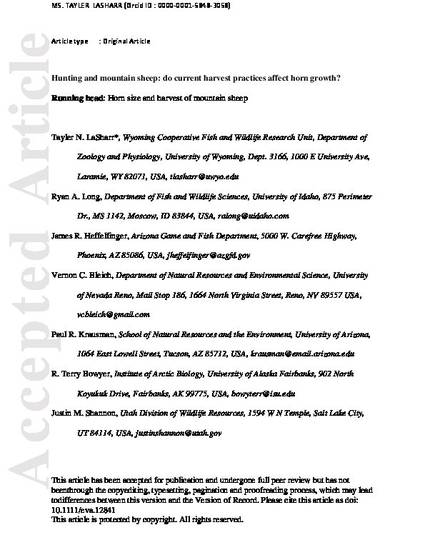
The influence of human harvest on evolution of secondary sexual characteristics has implications for sustainable management of wildlife populations. The phenotypic consequences of selectively removing males with large horns or antlers from ungulate populations has been a topic of heightened concern in recent years. Harvest can affect size of horn‐like structures in two ways: 1) shifting age structure toward younger age classes, which can reduce the mean size of horn‐like structures; or 2) selecting against genes that produce large, fast‐growing males. We evaluated effects of age, climatic and forage conditions, and metrics of harvest on horn size and growth of mountain sheep (Ovis canadensis ssp.) in 72 hunt areas across North America from 1981 to 2016. In 50% of hunt areas, changes in mean horn size during the study period were related to changes in age structure of harvested sheep. Environmental conditions explained directional changes in horn growth in 28% of hunt areas, 7% of which did not exhibit change before accounting for effects of the environment. After accounting for age and environment, horn size of mountain sheep was stable or increasing in the majority (~78%) of hunt areas. Age‐specific horn size declined in 44% of hunt areas where harvest was regulated solely by morphological criteria, which supports the notion that harvest practices that are simultaneously selective and intensive might lead to changes in horn growth. Nevertheless, phenotypic consequences are not a foregone conclusion in the face of selective harvest; over half of the hunt areas with highly selective and intensive harvest did not exhibit age‐specific declines in horn size. Our results demonstrate that while harvest regimes are an important consideration, horn growth of harvested male mountain sheep has remained largely stable, indicating that changes in horn growth patterns are an unlikely consequence of harvest across most of North America.
Available at: http://works.bepress.com/robert-klaver/83/

This is a manuscript of an article published as LaSharr, Tayler N., Ryan A. Long, James R. Heffelfinger, Vernon C. Bleich, Paul R. Krausman, R. Terry Bowyer, Justin M. Shannon et al. "Hunting and mountain sheep: do current harvest practices affect horn growth?." Evolutionary Applications. doi: 10.1111/eva.12841.